Attention, leaders of the world: your electric car has arrived. After years of environmental platitudes, our political poohbahs have probably emitted enough hot air to negate any benefit from travelling in this new EV; but in their world, it’s all about the optics.
When it comes to luxury saloons, there has only ever been one leader: the Mercedes S-Class. It’s the car against which all other six-figure stretched saloons are judged.
There’s a very simple test to define a benchmark car: when you buy one, no one asks why. For years that applied to the VW Golf among the mortgaged masses and the S-Class among the well-heeled and wealthy.
In this new electric age, the battery-powered luxury benchmark is meant to be this new EQS. Will it be the car of choice for image-conscious autocrats, corporate fat cats and well-heeled democrats seeking to boost their eco-credentials?
READ MORE
On first impressions, that’s not a sure-fire certainty. There’s no questioning the luxury and opulence of this new electric car. It’s a top-end Mercedes, after all, and at this level the folks at Stuttgart don’t cut any corners.
But they also have to face some engineering realities. Mercedes is eager to show that range is not an issue for its top-end EVs. That’s why in April it’s EQXX concept – soon to enter production – completed a journey of over 1,00km on a single charge. And it’s why Mercedes can rightly claim over 400km (and over 500km if driven gingerly) in real-world driving in this EQS.
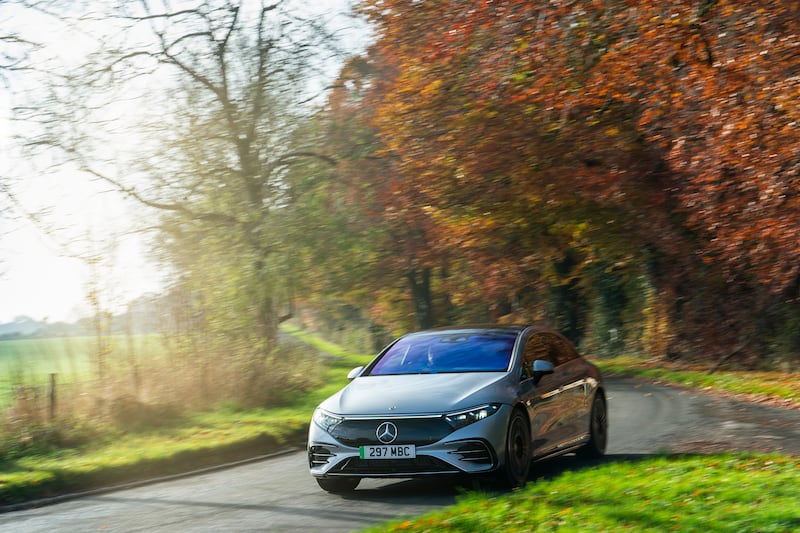
But to achieve these statistics the car needed to be aerodynamic – and that means a rather flaccid front nose. Does that matter? In the high-powered world where the S-Class exists, image is everything. These people want to make a statement when they arrive: it’s why so many of these cars are fitted with grilles the size of a sitting room radiator. It’s all about making a grand entrance. In that regard, the EQS has something of a limp handshake.
The EQS is certainly long enough. It’s certainly luxurious enough. But it needs a more imposing front nose. It’s a pedantic point, but when you are paying €130,000 or more (probably quite a bit more when you load on some extras), then you are entitled to be a bit pernickety.
Marshmallow hug
Inside, there’s a level of comfort you’d normally associate with a five-star hotel. Take the seats; it’s like being hugged by a marshmallow. Our test car came with extra soft pillows on the headrests. All that was missing was a duvet.
The dash is dominated by Merc’s truly massive “hyperscreen” system. Even our most jaded techie friend, who hasn’t been excited by any innovations since the iPhone, emitted an involuntary “wow” when he first saw this three-screen dash set-up. It makes Tesla’s touchscreen system look like a black-and-white TV from the 1950s. We elicited a second “wow” when we mentioned the price: the test car’s hyperscreen three-screen set-up added an extra €12,213 to the price. You could buy a boot full of tablet computers for that price.
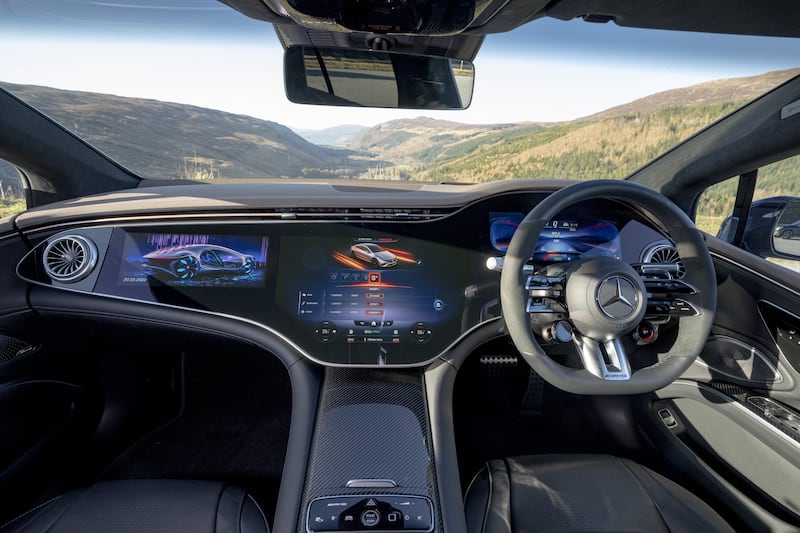
We needn’t go into the long list of comfort features on this car, such as multiple seat massage settings, a sound system to rival a concert hall or a lighting set-up that lures you back behind the wheel at night just to enjoy the show. Suffice to say, Mercedes has delivered upon expectations on the cabin front. It’s voluptuous and extravagant, if a little bling.
Mercedes has also impressed when it comes to the battery range. The on-board predictive system in our test car – a 450+ version with a single electric motor driving the rear wheels – promised figures in the region of 650km. Although we never ran it down to the limit, it did manage to achieve consumption levels during regular driving – even when heavy on the throttle – that would easily deliver 450km-plus.
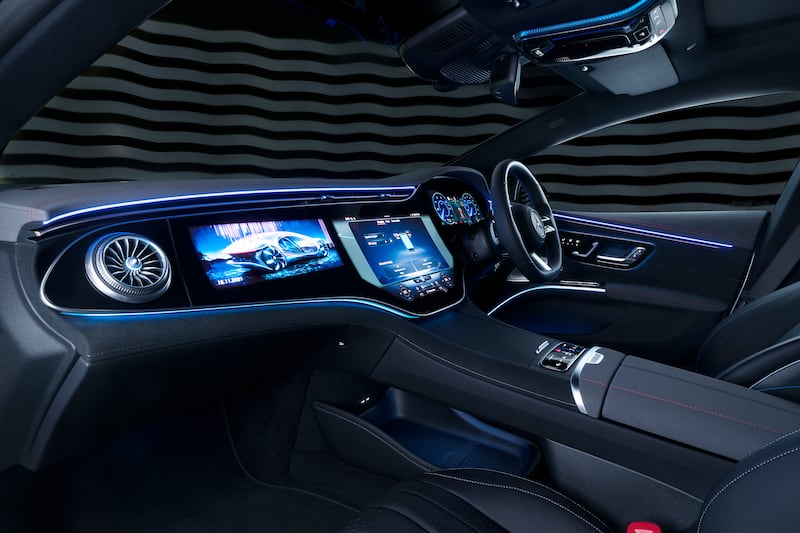
Actually, Mercedes claims this 450+ version of the EQS can do 717km on a single charge, which surely calls time on any range anxiety. This EQS is also capable of taking a charge from the DC rapid chargers of up to 200kW, which means in optimum conditions you could get 300km of charge in just 15 minutes.
The battery pack offers 107.8kWh of usable power, housed in a steel and aluminium casing integrated into the cabin floor, giving the EQS a much lower centre of gravity than the equivalent S-Class. That should mean it’s got even more deft handling than its combustion-engined sibling.
Strangely, that’s not quite the case. This is a big, heavy car – weighing in at 2.5 tonnes – and it frequently feels its size. Don’t get me wrong, it’s ridiculously rapid. A 0-100km/h time of 6.2 seconds doesn’t do justice to just how fast this behemoth can move. Tip the throttle at 40km/h and you’ll have overtaken that truck and challenged the speed limit in the blink of an eye.
It does corner well, but seemingly tuned to oversteer, despite its rear-wheel-drive format. Perhaps that because it lays down so much power through the back wheels and potential owners won’t fancy a tail-happy luxury saloon. In regular driving, it’s a very relaxed car and surprisingly nimble in the city, with a very impressive turning circle.
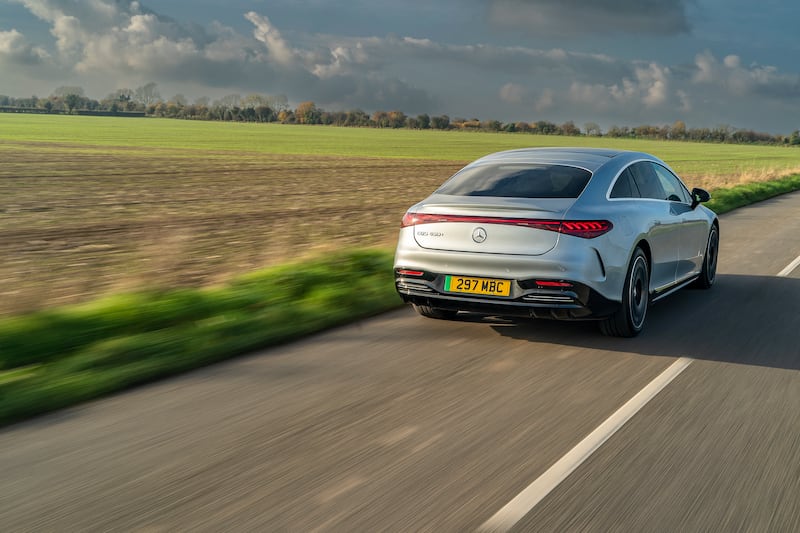
Drive it with more enthusiasm, however, and the EQS is neither lithe nor nimble. Strangely, despite the lower centre of gravity it doesn’t quite hit the same level of dynamic ability as the S-Class. That’s not helped by a brake-pedal feel that’s initially far too light. The EQS could really do with a more reassuring brake biting point for a car of this size. It’s probably the single biggest flaw in this car’s set-up.
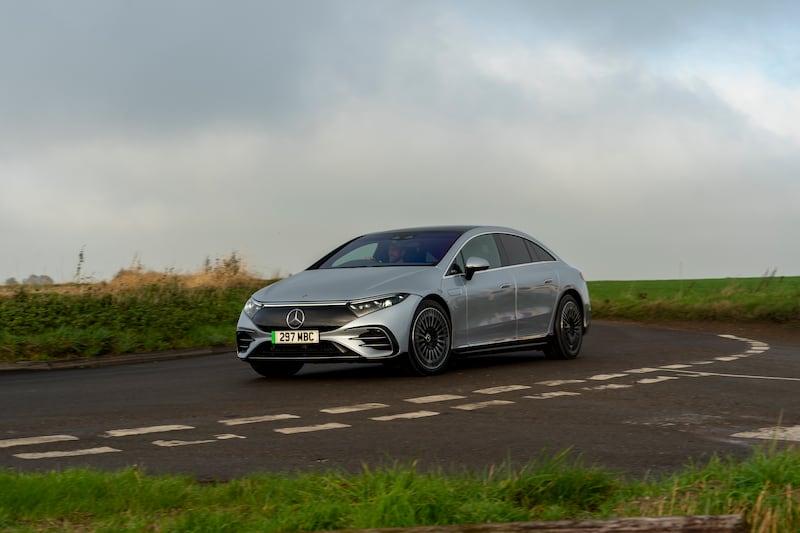
Less refined
The ride can also be a little less refined than the S-Class, particularly over the worst of Irish roads. Admittedly it’s a heavy car, but you can sense the suspension hard at work in a way that never happens on the S-Class.
Up at these heady six-figure euro heights, there isn’t a long line of rivals, but for anyone devoted to electric, you could consider the Porsche Taycan or the Audi RS e-tron GT, one of the best cars we’ve driven this year.
For loyal Mercedes owners, the new EQS – for all its engineering excellence and remarkable range – doesn’t quite have the same benchmark capability as its sibling. Unlike the S-Class, buyers of the EQS will still have to answer the question “why”.













